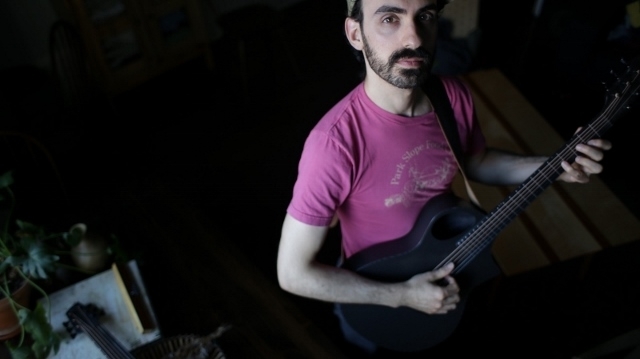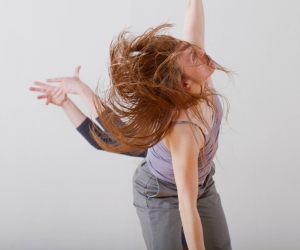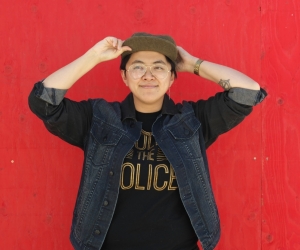
(This article was originally published in Spring 2015.)
Myk Freedman is best known as the lap-steel-wielding leader of the nonet St. Dirt Elementary School, whose idiosyncratically tuneful music (released on Rat Drifting and on Barnyard Records) is nestled in the crevice between whimsy, sentimentality, and ragtag experimentation. Ostensibly a jazz group, its diverse instrumentation, wonkiness, and the sweetly pithy character of Freedman’s tunes conjure the likes of Jerry Byrd, Sun Ra, the Penguin Café Orchestra, and Charles Mingus.
Freedman is also the name of a Toronto outfit (Justin Haynes, Ryan Driver, and Jean Martin) that has toured and recorded Freedman’s compositions with a suitably odd instrumentation of ukelele, street-sweeper-bristle bass, and suitcase (a drum-kit substitute). In 2009, the noted American label Porter records released Julu Twine, a pastoral album of woozy improvisations featuring Freedman in duet with legendary U.S. multi-instrumentalist Alan Sondheim. He’s also performed with John Zorn, William Parker, Elliot Sharp, and Cyro Baptista.
After completing studies at York University, Freedman moved in 2003 to New York, where he studied at the New School with William Parker and Mark Dresser. He later worked privately with Anthony Coleman. He’s been playing in Joey Weisenberg’s Hadar Ensemble (which blends traditional Jewish religious vocal music with contemporary Brooklyn jazz, soul, bluegrass and more) and in the ambient ensemble Bing & Ruth, in addition to leading his own group, Myk Freedman and the Myk Freedmans.
Recently, Freedman has been working daily to craft an album of solo (regular) guitar renditions of some of his many compositions.
Musicworks: What’s behind doing a solo guitar record?
Myk Freedman: A big part of why I’ve been working on guitar more now is that I’m looking after my kid full time during the day, and I’m able to play guitar with him around. Now that he walks, he just wants to jump on the lap-steel. Getting out regularly to play my music with other people is tricky; you can cover a lot of ground on the guitar, such that you’re capturing the energy or spirit of a large group by yourself.
MW: How has working solo affected your approach to composing?
MF: In the past, my music was designed as a springboard for group improvisation within the framework of the tunes. I loved having room for different dynamics and interactions within the ensemble. Now I’m striving to keep that headspace to myself, which is complicated. I’m coming up with arrangements, some of them quite specific, and this foundation helps set the stage so that I end up in more interesting places. Throughout the creative process, I thought a lot about the people who played the pieces before: choosing these familiar pieces fuels an interaction between the guitar and something other than just myself. I’m interacting with the history of the pieces as well—bringing in elements from previous interpretations. One thing Anthony Coleman told me, which had a huge impact, is that before he records a tune he researches its history. When he was working on the standard “Dinah,” he amassed something like 150 recordings of it and would listen to all of them. There was one notable solo that he heard remnants of several versions later. The reference might be very clear or really obscure, but because Coleman got so deep into that tune, it all made sense to him. It was only after digesting this deep history that he’d feel ready to go perform it himself. With my process, there’s a similar thread.
MW: How are you negotiating issues surrounding the pared-down instrumentation?
MF: One rule I had with St. Dirt—and any group I’ve led—was that if you don’t like what you’re playing or you don’t feel good at the gig, it’s your fault because you can change what’s happening. You’re free! If you think you’re supposed to be playing a certain way, you’re mistaken: I’ve invited you to join to be yourself. I keep this idea in mind when I feel blocked—even from the point view of technical limitations. I ask myself, “Why is there an expectation that I have to continue playing in a certain way?” Playing solo, I can move things around—tempo, form, etc.—to achieve more freedom and fluidity.
MW: Working solo is intensely personal. How has that dimension grown for you?
MF: Before I started working on this album, I never had a sense of what I sound like just playing my music alone, and whether it’s actually interesting. I wanted to find that out, so I started recording myself every day and listening back in different contexts. In the beginning, I was envisioning the record on electric guitar, but when I’d listen back, it sounded too much like mediocre jazz playing. I decided I needed to find my own tone that would separate me from the expectations many people have when they hear solo guitar. My current setup is an acoustic carbon-fibre travel guitar with a contact mike on it, routed to two different amps. Hopefully, now when you hear me play an open E chord, your brain doesn’t go to the millions of places it could go! I actually played a solo gig last week of these older tunes and I was really nervous—and I don’t really get nervous ever.
MW: Is there a meditative aspect to this process?
MF: I’m currently coming off some pretty big life changes. One thing I did in the last several years was get deep into practicing yoga. When you’re doing yoga, you’re looking at where your mind goes when you meditate. You’re not judging, but examining it or observing it. Right now I’m doing something similar in reflecting on my past. I could’ve written all new music, but I guess there is a sense of sorting out some self things. There’s a comfort in going back, while you’re going forward.
Audio: Deer Park United (2014), composed and performed by Myk Freedman (acoustic guitar). Photo of Myk Freedman by: Ilusha Tsinadze .


